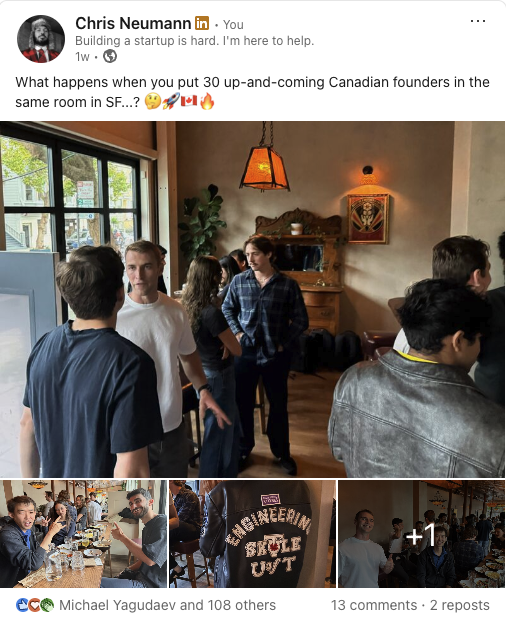Things I Think I Think - Q3 2025
The memories of summer are already starting to fade away. Burning Man is over. So is the After Burn. And the After After Burn. Best of all? The kids are back in school 🙌. Time to shift gears and get into fall with my latest homage to legendary sports columnist Peter King.
Here are 5 Things I Think I Think - Q3 2025 Edition:
1. Orange is the New Triple, Triple, Double
It used to be that venture capitalists’ preferred roadmap for success was the “triple, triple, double, double, double”. The path is simple (at least, according to MBA-types who’ve never actually run a business): Just get to $1.5M in revenue, then triple it the following year. And triple it the year after that. And then double it for the next three years. Voila! You’ve got a $100M business and are ready to go public.
Now, some VCs are latching onto an even more audacious blueprint. Hemant Taneja of General Catalyst recently had this to say:
“Triple, triple, double, double is definitely dead. I tell our investors: don’t bring that to me <laugh>…Going from $1M to $3M to $9M is not interesting…you gotta go, like, $1M to $15 - $20M to $100M.”
His comments were polarizing, to say this least.
As aloof as Hemant’s comments might seem, they reflect the converging perspective of a growing number of VCs. At the start of the summer, I wrote about some of the changes that are happening amongst early-stage investors. In the post, I shared the following anecdote:
“I [recently] met a founder who was extremely frustrated with the lack of progress they’d made raising capital from VCs. In relaying their experience to me, the founder proclaimed that they had a stellar founding team with an amazing track record, a working prototype and clear evidence of a market need. Yet they were getting zero traction with investors.
Later that day, I looked up the founder’s company and thought to myself, “what a nice, incremental business.”
…
To be clear, there was nothing wrong with this founder’s business. It was — and is — a perfectly reasonable B2B SaaS company. The type that was built to solve a real problem and that very likely would have been able to raise VC funding 2 years ago (not because of ZIRP, but because it is a perfectly reasonable company solving a real problem).
Yet in comparison to AI companies, with their unprecedented growth trajectories, and deep tech companies, with their imagination-bending potential, it just felt…
…incremental.”
It used to be that a startup achieving “triple, triple, double, double, double” growth was rare and exciting. Only the best-of-the-best could achieve it. Now, the definition of “exceptional” growth has fundamentally changed. And, like it or not, VCs chasing power law outcomes can’t unsee that.
2. But, But, But…
As much as some VCs — particularly those associated with Silicon Valley’s billion-dollar funds — are extolling the virtues of these AI-driven money machines, other investors are raising the alarms.
So what does all this mean for founders?
For starters, if your company is building an AI-first “prosumer” product — or anything where distribution should reasonably follow AI adoption — this type of extreme growth is what investors are looking for. But, more than that, if you’re any type of SaaS-y company, this is the benchmark against which you’re now being compared.
That may not seem fair, but it’s happening.
We’re now seeing companies go from zero to $10M in ARR (or more) in less than two years with an increasing degree of regularity. To be clear, this is still very much the exception to the rule, but it’s occuring frequently enough that a small but growing number of VCs are holding their dry power until and unless they see such growth.
At the same time, many investors are questioning how sticky this revenue will be. What percentage of these companies will be able to maintain their revenue and customer base after the initial growth explosion (vs. seeing it collapse like a house of cards)? At this point, we simply don’t know. So while some VCs are tripping over themselves to chase these extreme growth companies, others are steering clear.
If you’re a founder raising capital this fall, my biggest advice is to cast a wide net. There’s a lot of capital flowing right now, but also an unusual degree of opacity around what individual investors are looking for.
3. A Tale of Two Ecosystems
Speaking of capital flowing, the difference between what’s happening in Silicon Valley right now and what we’re seeing in the rest of the world couldn’t be more stark.
It’s only one month into the fall fundraising season and I’ve seen dozens of pre-seed deals happen in the Bay Area in only days, while Seed and Series A rounds are going from first meeting to term sheets in 1-2 weeks. By contrast, I’ve spoken with founders in Canada, the UK and elsewhere who are struggling to get local investors across-the-line. Why the difference?
Outside of the U.S., the dry powder we’ve been hearing so much about for the past few years is starting to dry up.
Take Canada, for example, According to a recent Betakit article,
“Canadian VCs, particularly emerging managers, are struggling to raise new capital. According to BDC, only 17 funds raised a total of $2 billion in 2024, marking a year-over-year decline in dollars raised and average fund size. The share of emerging managers is shrinking: the report shows that established managers, considered to be those who have raised more than three funds, now make up 20 percent of active GPs—the largest share in a decade.”
To put that in context, in 2024 a16z raised 3.6x as much capital as all Canadian VCs combined.
A year later, we’re starting to see the impact. According to the Canadian Venture Capital Association, in the first half of 2025 there was “…a 26% decline in dollars invested and a 22% drop in deal count [by Canadian VCs] compared to H1 2024.”
Why does this matter?
Throughout the world, early-stage funding rounds are overwhelmingly led by local investors. A small percentage of international founders each year succeed in raising capital from Silicon Valley VCs, but the vast majority rely on local VCs and angels for their first few rounds of funding. The mythical U.S. lead investor is just that: a myth. A reduction in early-stage domestic capital can, therefore, have a long-term negative impact on a country’s entire tech ecosystem.
A drop in the share of emerging managers (newer VCs) is an even bigger red flag for a country’s startup ecosystem.
Bottom line: if institutional and corporate LPs outside of the U.S. continue to sit on their hands, their countries risk missing out on what looks to be the biggest and most consequential technological (and economic) shift in our lifetimes.
So yeah…it’s a big deal.
4. Founders Are On the Move
While VCs in some countries are struggling, founders are sprinting as fast as they can. And going wherever they need to.
A few weeks ago, I reached out to a handful of young Canadian founders about putting together an impromptu mixer in San Francisco. I figured 10 or 12 might show up. More than 30 founders descended on the bar in Lower Haight (much to the chagrin of some of the locals).
That might not seem like a big deal, but consider this: nearly half of them flew in from Vancouver, Toronto and Montreal just for this event.
For awhile now, I’ve observed an increasing mobility amongst founders — particularly Gen Z founders — who seem utterly unencumbered by the cost or complexity of going back-and-forth between cities. As someone who’s spent a long time championing the importance of spending time in Silicon Valley, I consider this a strong signal when it comes to the potential of the next generation of founders. But even I’ve been shocked by how quickly and widely their expat networks are expanding — often without any involvement or support of past generations of founders.
There’s a lot to unpack here (and I plan to in a future post), but for now I’ll say this: the mental model that the current generation of founders has when it comes to operating in and across multiple ecosystems if fundamentally different than generations past. And that’s really exciting.
5. Speaking of On the Move
The past few weeks in Startupland™ have been dominated by coverage of the U.S. administration’s introduction of a $100,000 fee on H-1B applications. Since that announcement was made, multiple countries — from Canada to China — have introduced or are in the process of introducing policies designed to lure foreign workers away from the U.S.
While those efforts are domestically very popular, I continue to believe that the reactions to the policy change (both inside and outside of the U.S.) are much ado about nothing. While some people and companies will undoubtedly be impacted by the change, I don’t believe that this will result in a sudden flow of talent away from the U.S. Here’s what Democrat megadonor Reed Hastings had to say:
Reed’s take was certainly against the flow when it came to Silicon Valley reactions, but I think it’s the correct one if you reframe the categorization of high tech visas as follows:
H-1Bs will be used for very high value jobs
O-1s will be used for very high value people









